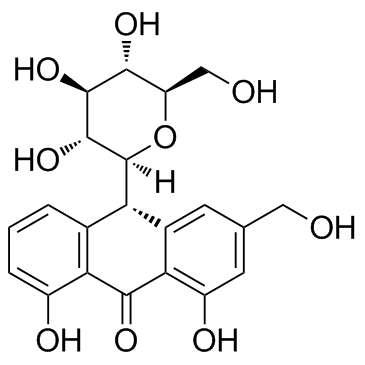Aloin

Aloin structure
|
Common Name | Aloin | ||
|---|---|---|---|---|
| CAS Number | 1415-73-2 | Molecular Weight | 418.394 | |
| Density | 1.6±0.1 g/cm3 | Boiling Point | 752.6±60.0 °C at 760 mmHg | |
| Molecular Formula | C21H22O9 | Melting Point | 148-149ºC | |
| MSDS | Chinese USA | Flash Point | 268.0±26.4 °C | |
| Symbol |

GHS07 |
Signal Word | Warning | |
|
The content of secondary phenol metabolites in pruned leaves of Aloe arborescens, a comparison between two methods: leaf exudates and leaf water extract.
J. Nat. Med. 62(4) , 430-5, (2008) Aloe arborescens plants, originating from the deserts of South Africa, are grown in the Introduction Garden at Sede Boker in the Negev Desert of Israel. In previous studies, we developed agro-technical methods to raise the content of secondary phenol metaboli... |
|
|
Determination of aloenin, barbaloin and isobarbaloin in aloe species by micellar electrokinetic chromatography.
J. Chromatogr. B. Biomed. Sci. Appl. 752(1) , 91-7, (2001) Aloenin, barbaloin and isobarbaloin in JP Aloe, Aloe barbadensis (Aloe vera) and Aloe arborescens Miller var. natalensis Berger (Aloe arborescens Miller) were determined by micellar electrokinetic chromatography (MEKC) with 50 mM sodium dodecyl sulfate. Aloen... |
|
|
Liquid chromatographic determination of barbaloin (aloin) in foods.
J. Assoc. Off. Anal. Chem. 68(3) , 493-4, (1985) A simple and rapid liquid chromatographic method is described for the determination of barbaloin (aloin, 10-D-glucopyranosyl-1,8-dihydroxy-3-(hydroxymethyl)-9(10H)-anthraceno ne) in foods. Barbaloin is extracted with water from foods containing aloe and the e... |
|
|
Isolation of a human intestinal bacterium capable of transforming barbaloin to aloe-emodin anthrone.
Planta Med. 57(1) , 15-9, (1991) A strictly anaerobic bacterium, Eubacterium sp. BAR, was isolated from human feces as one of the intestinal bacteria capable of metabolizing barbaloin. The bacterium grew in PYF broth containing barbaloin and converted barbaloin to aloe-emodin anthrone. On th... |
|
|
Metabolism of barbaloin by intestinal bacteria.
Chem. Pharm. Bull. 36(11) , 4462-6, (1988)
|
|
|
Barbaloin stimulates growth of Eubacterium sp. strain BAR, a barbaloin-metabolizing bacterium from human feces.
Chem. Pharm. Bull. 39(3) , 757-60, (1991) Eubacterium sp. strain BAR, isolated from human feces, transformed barbaloin to aloe-emodin anthrone in a basal medium lacking carbohydrate. Barbaloin remarkably stimulated the growth of strain BAR in the basal medium, the stimulative extent of the growth dep... |
|
|
Studies of aloe. V. Mechanism of cathartic effect. (4).
Biol. Pharm. Bull. 17(5) , 651-3, (1994) Aloe-emodin-9-anthrone(AE-anthrone), produced from barbaloin in the rat large intestine, caused not only an increase in the intestinal water content but also stimulated mucus secretion. This might play an important role in the occurrence of diarrhea. It was d... |
|
|
Antioxidant actions of phenolic compounds found in dietary plants on low-density lipoprotein and erythrocytes in vitro.
J. Am. Coll. Nutr. 26(3) , 233-42, (2007) There is increasing interest in the study of the antioxidant actions of plant phenolic compounds as evidence shows that consumption of plant products rich in these compounds contributes to protection from a number of ailments including cardiovascular diseases... |
|
|
Cleavages of the O- and C-glucosyl bonds of anthrone and 10,10'-bianthrone derivatives by human intestinal bacteria.
Pharmacology 47 Suppl 1 , 125-33, (1993) A strictly anaerobic bacterium, Bifidobacterium sp. SEN, capable of hydrolyzing the O-glucosyl of sennosides was isolated from human feces. The bacterium stepwisely hydrolyzed sennoside B to sennidin B through sennidin-8-monoglucoside in PYF medium but not in... |
|
|
Fluorescence studies on the interactions of barbaloin with bovine serum albumin.
Chem. Pharm. Bull. 51(5) , 579-82, (2003) The fluorescence quenching reactions of barbaloin with bovine serum albumin (BSA) in pH 7.20 Tris-HCl buffer solution were studied. The quenching mechanism of BSA by barbaloin was interpreted using the Stern-Volmer (S-V) mechanism. The binding constant K valu... |